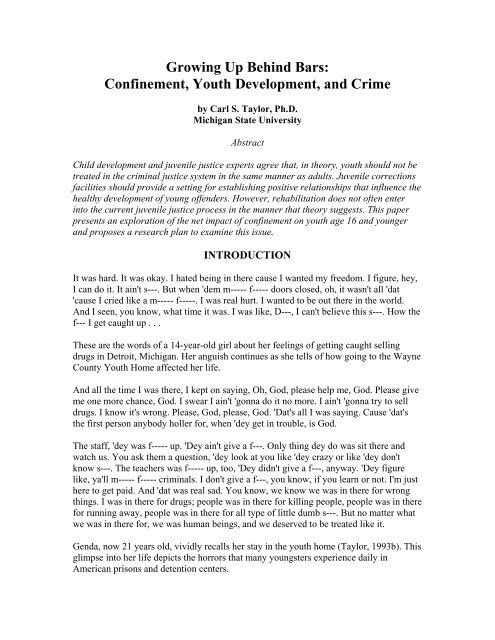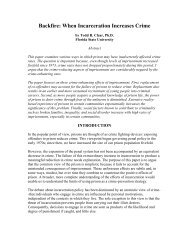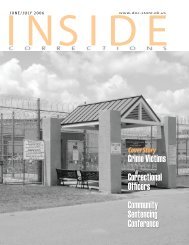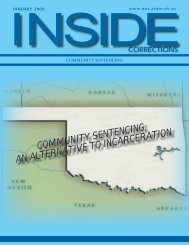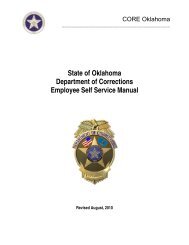Growing Up Behind Bars - Oklahoma Department of Corrections
Growing Up Behind Bars - Oklahoma Department of Corrections
Growing Up Behind Bars - Oklahoma Department of Corrections
Create successful ePaper yourself
Turn your PDF publications into a flip-book with our unique Google optimized e-Paper software.
<strong>Growing</strong> <strong>Up</strong> <strong>Behind</strong> <strong>Bars</strong>:<br />
Confinement, Youth Development, and Crime<br />
by Carl S. Taylor, Ph.D.<br />
Michigan State University<br />
Abstract<br />
Child development and juvenile justice experts agree that, in theory, youth should not be<br />
treated in the criminal justice system in the same manner as adults. Juvenile corrections<br />
facilities should provide a setting for establishing positive relationships that influence the<br />
healthy development <strong>of</strong> young <strong>of</strong>fenders. However, rehabilitation does not <strong>of</strong>ten enter<br />
into the current juvenile justice process in the manner that theory suggests. This paper<br />
presents an exploration <strong>of</strong> the net impact <strong>of</strong> confinement on youth age 16 and younger<br />
and proposes a research plan to examine this issue.<br />
INTRODUCTION<br />
It was hard. It was okay. I hated being in there cause I wanted my freedom. I figure, hey,<br />
I can do it. It ain't s---. But when 'dem m----- f----- doors closed, oh, it wasn't all 'dat<br />
'cause I cried like a m----- f-----. I was real hurt. I wanted to be out there in the world.<br />
And I seen, you know, what time it was. I was like, D---, I can't believe this s---. How the<br />
f--- I get caught up . . .<br />
These are the words <strong>of</strong> a 14-year-old girl about her feelings <strong>of</strong> getting caught selling<br />
drugs in Detroit, Michigan. Her anguish continues as she tells <strong>of</strong> how going to the Wayne<br />
County Youth Home affected her life.<br />
And all the time I was there, I kept on saying, Oh, God, please help me, God. Please give<br />
me one more chance, God. I swear I ain't 'gonna do it no more. I ain't 'gonna try to sell<br />
drugs. I know it's wrong. Please, God, please, God. 'Dat's all I was saying. Cause 'dat's<br />
the first person anybody holler for, when 'dey get in trouble, is God.<br />
The staff, 'dey was f----- up. 'Dey ain't give a f---. Only thing dey do was sit there and<br />
watch us. You ask them a question, 'dey look at you like 'dey crazy or like 'dey don't<br />
know s---. The teachers was f----- up, too, 'Dey didn't give a f---, anyway. 'Dey figure<br />
like, ya'll m----- f----- criminals. I don't give a f---, you know, if you learn or not. I'm just<br />
here to get paid. And 'dat was real sad. You know, we know we was in there for wrong<br />
things. I was in there for drugs; people was in there for killing people, people was in there<br />
for running away, people was in there for all type <strong>of</strong> little dumb s---. But no matter what<br />
we was in there for, we was human beings, and we deserved to be treated like it.<br />
Genda, now 21 years old, vividly recalls her stay in the youth home (Taylor, 1993b). This<br />
glimpse into her life depicts the horrors that many youngsters experience daily in<br />
American prisons and detention centers.
And when I used to talk to the staff and stuff, I used to go by the desk in a little <strong>of</strong>fice,<br />
she used to be like, don't come pass 'dat line. I'm like, what you mean, don't come pass<br />
'dat line? Like I said, don't come pass 'dat. I said, why; you think we some kind <strong>of</strong> disease<br />
or somethin'?<br />
And she used to be there at night, so when nighttime, you know, when you go all in your<br />
room, 'dey lock the doors and s---. So, I used to be knockin on the door at night, 'cause I<br />
used to have to use the bathroom cause I had a bad bladder infection. And I used to be<br />
bam, bam, bam, Ms. Doe, Ms. Doe. Bam, bam, bam. The b---- ain't never answered the<br />
door. And so I was like, f--- it. She didn't give a f---, so I didn't give a f---. So I pulled my<br />
m----- f----- shorts down and I p----- on the m----- f----- floor. And I know I was a<br />
criminal, and I know what I had done was wrong by sellin' drugs, but I do got my m-----<br />
f----- rights, and I know 'dat b---- is supposed to open the door and let me p---. I know<br />
'dat m----- f----- much.<br />
The American criminal justice system historically has treated juveniles differently from<br />
adult <strong>of</strong>fenders, believing that their judgment and sense <strong>of</strong> responsibility are less<br />
developed and that their potential for rehabilitation is greater. In theory, fostering positive<br />
mental, emotional, and physical development is an integral part <strong>of</strong> the juvenile<br />
corrections process. However, contemporary circumstances have shifted the focus from<br />
children in trouble to menacing youth whom the public should fear. Young people<br />
committing serious <strong>of</strong>fenses have captured headlines and media attention, fueling<br />
feelings that detention centers and correctional institutions for juveniles have become s<strong>of</strong>t<br />
and that America needs to crack down on juvenile <strong>of</strong>fenders. Policymakers have reacted<br />
by legislating more severe punishments for violent or habitual <strong>of</strong>fenders. Many states<br />
have made it easier to sentence serious juvenile <strong>of</strong>fenders as adults--in effect, scrapping<br />
efforts to rehabilitate juvenile <strong>of</strong>fenders in favor <strong>of</strong> purely punitive actions. However,<br />
there is no empirical evidence that long sentences reduce youth crime (Singer &<br />
McDowall, 1987).<br />
The Literature, tells us that juvenile incarceration has not been particularly successful in<br />
producing better young citizens (Fagan, 1990; Krisberg, 1992). The contrast between<br />
youth development theory, which defines and supports the quest <strong>of</strong> all adolescents to<br />
become healthy adults, and the realities <strong>of</strong> juvenile incarceration is extreme and<br />
disturbing. Youth development theory emphasizes growth and expansion, and symbolizes<br />
society's positive expectations. In turn, juvenile justice is too <strong>of</strong>ten characterized by<br />
inconsistent laws, policies, and enforcement rates, and the systematic oppression <strong>of</strong><br />
young people.<br />
In some communities, juvenile detention facilities are simply the anticipated first stop on<br />
a road leading directly to the"big league": adult prison (Scott, 1993). Confinement in<br />
juvenile facilities may fail to deter criminal behavior because the experience has become<br />
normalized within many youngsters' lives--forming an outlaw subculture (Taylor, 1989).<br />
Not only do these youth expect to spend time in detention, some think <strong>of</strong> it as a rite <strong>of</strong><br />
passage (Scott, 1993). The localized belief that going away to prison is normal is a direct
consequence <strong>of</strong> certain groups being disproportionately incarcerated over the decades<br />
(Mann, 1993; Taylor, 1989, 1993a, 1993b).<br />
This paper explores what crime rate data, juvenile corrections data, and youth<br />
development theory suggest about the cumulative impact <strong>of</strong> America's confinement <strong>of</strong><br />
youth 16 years old and younger.<br />
Magnitude <strong>of</strong> the Problem<br />
Between 1984 and 1992, the arrest rates (per 100,000 inhabitants) <strong>of</strong> youth under 18<br />
years <strong>of</strong> age increased from 1,176 to 1,306 (Bureau <strong>of</strong> Justice Statistics, 1994). More<br />
recently in 1993, 2,014,472 juveniles under age 18 were arrested, 77% <strong>of</strong> whom were 16<br />
years and younger (<strong>Department</strong> <strong>of</strong> Justice, 1994; Federal Bureau <strong>of</strong> Investigation, 1992).<br />
Most members <strong>of</strong> this younger group, 55%, were between the ages <strong>of</strong> 13 and 16, and<br />
were arrested for committing property crimes (84%).<br />
In 1988, Congress directed the Office <strong>of</strong> Juvenile Justice and Delinquency Prevention<br />
(OJJDP) to assess conditions <strong>of</strong> confinement for juveniles, to determine the extent to<br />
which detention facilities conform to recognized national and pr<strong>of</strong>essional standards, and<br />
to recommend ways to improve conditions. 1 The study, known as Conditions <strong>of</strong><br />
Confinement (1994), surveyed all 984 public and private juvenile detentions centers,<br />
reception centers, training schools, ranches, camps, and farms. (The study excluded<br />
police lockups, adult jails, and facilities that hold juveniles tried and convicted as adults;<br />
as well as halfway houses, shelters, group homes, and psychiatric and drug treatment<br />
programs.) The study was commissioned in part to help remedy the serious problem <strong>of</strong><br />
overcrowding in juvenile facilities. In 1987, 36% <strong>of</strong> confined youth were jailed in<br />
facilities whose populations exceeded their design limits. In 1991, overcrowding had<br />
increased to 47%; one-third were living in sections with 26 or more people; one-third<br />
were sleeping in rooms too small to meet national standards (Office <strong>of</strong> Juvenile Justice<br />
and Delinquency Prevention, 1994; hereafter cited as Confinement). Overcrowding has<br />
significant effects. For example, large dormitory facilities reported more youth-on-youth<br />
incidents when the population exceeds capacity (Confinement).<br />
Admissions to juvenile facilities rose after 1984 and reached an all-time high <strong>of</strong> nearly<br />
690,000 in 1990. The largest increase was in detention, where admissions rose from just<br />
over 400,000 in 1984 to about 570,000 in 1990 (Confinement). Children in Custody<br />
(CIC) census counts reveal that on any one day in 1991 about 65,000 youth were<br />
confined, 56% in medium or maximum security facilities.<br />
In 1991, most confined youth (88%) were male. Between 1987 and 1991, the proportion<br />
<strong>of</strong> minorities among confined juveniles rose from 53 to 63%. Specifically, the proportion<br />
<strong>of</strong> African-Americans increased from 37 to 44% (Confinement).<br />
Beyond these numbers, fundamental human needs are not being met in some youth<br />
centers. The OJJDP study revealed that the most alarming and prevalent problems in<br />
juvenile facilities involved living space, security, control <strong>of</strong> suicidal behavior, and health
care--four areas that directly impact positive youth development. Alarmingly, in 1991,<br />
more than 11,000 juveniles engaged in more than 17,000 incidents <strong>of</strong> suicidal behavior<br />
while confined in juvenile facilities (Confinement). Clearly, rehabilitation is stymied<br />
because it is difficult to address self-esteem, education, or training when individuals are<br />
lacking the basics: safe living conditions and high-quality mental and physical health<br />
services.<br />
The Case <strong>of</strong> Wayne County<br />
The Wayne County Youth Detention Facility, based in Detroit, Michigan, is symbolic <strong>of</strong><br />
what plagues other urban centers. Wayne County was cited by the Justice <strong>Department</strong> for<br />
its poor treatment <strong>of</strong> juveniles in December <strong>of</strong> 1994. 2 This facility has been poorly run for<br />
the past three decades. The physical edifice was shameful. The outer grounds were dirty<br />
and unkempt. The building was in desperate need <strong>of</strong> painting, cleaning, and repair. <strong>Up</strong>on<br />
entering the front vestibule, this author was unnerved by the stench <strong>of</strong> urine. Youth were<br />
constantly being shuffled into overcrowded rooms. Staff morale was low, caused in<br />
particular by a rapid succession <strong>of</strong> executive directors and a lack <strong>of</strong> in-service training.<br />
Parents <strong>of</strong> children in the facility described mistreatment and abuse. The youth<br />
complained about poor hygiene and health services. A physician who received patients<br />
from the Wayne County Detention Facility confirmed their complaints. The doctor was<br />
especially concerned about the lax health care in the face <strong>of</strong> serious public health issues<br />
such as AIDS. What these youth encountered upon entering and endure throughout their<br />
stay at this facility was captured in Genda's pr<strong>of</strong>ane, yet richly descriptive words.<br />
Developmental Systems Theory<br />
Over the past two decades, human development has increasingly come to be understood<br />
as a function <strong>of</strong> the relationship between the maturing individual and his or her changing<br />
environment (Bronfenbrenner, 1979; Gottlieb, 1992; Lerner, 1991, 1995; Magnusson,<br />
1988; Riegel, 1975; Samer<strong>of</strong>f, 1983; and Thelen & Smith, 1994;). This basic model is<br />
known as developmental systems theory (Ford & Lerner, 1992) because development is<br />
viewed as occurring on many levels simultaneously: biological, psychological,<br />
interpersonal, familial, societal, cultural, physical ecological, and historical.<br />
In the field <strong>of</strong> adolescent development, developmental systems models constitute the<br />
predominant theoretical approach. However, almost no information about links between<br />
youth development and the experience <strong>of</strong> incarceration exists. This void is perplexing<br />
given that nationally the juvenile violent crime arrest rate has risen by 50% in just five<br />
years (Annie E. Casey Foundation, 1994). Indeed, this author has uncovered only one<br />
paper, currently under preparation, that attempts to frame the incarceration experience<br />
within the context <strong>of</strong> developmental theory (Walters-Chapman & Walters-Chapman, 3<br />
pending).<br />
Accordingly, if developmental theory is to become relevant to the experiences <strong>of</strong> a broad<br />
range <strong>of</strong> adolescents, researchers must address how burgeoning rates <strong>of</strong> youth violence,<br />
arrests, and incarceration affect development. Key issues include:
• the aspects <strong>of</strong> the incarceration context that influence development, the features <strong>of</strong><br />
development that are affected (e.g., emotional, cognitive, social, moral/ethical)<br />
and in what ways; and<br />
• how the development <strong>of</strong> incarcerated youth compares to nonincarcerated youth.<br />
Because most youth in detention come from lower socioeconomic backgrounds, are<br />
African-American or Hispanic, and grew up in troubled homes, it is necessary to consider<br />
how these contextual variables influence their development, apart from the experience <strong>of</strong><br />
incarceration. However, very little is known about the typical developmental pathways <strong>of</strong><br />
these youth. Developmental theory is largely based on studies <strong>of</strong> white, middle-class,<br />
male, nonincarcerated youth. The lack <strong>of</strong> knowledge in this area is especially problematic<br />
for African-American adolescent males, who experience the greatest likelihood <strong>of</strong> being<br />
involved in the juvenile justice system. Without adequate norms, it is impossible to gauge<br />
the effects <strong>of</strong> incarceration on development. How can we know if incarceration slows<br />
down, arrests, maintains, or promotes particular developments if we do not have baseline<br />
and normative data against which to compare the effects <strong>of</strong> incarceration? It is equally<br />
impossible to understand how the incarceration experience may remediate behavioral or<br />
developmental problems, prevent the burgeoning <strong>of</strong> such problems, or promote the future<br />
positive development <strong>of</strong> youth. Absent information on disadvantaged youth, we must<br />
reflect on those developmental issues which are thought to apply to all adolescents in<br />
American society.<br />
Developmental Tasks <strong>of</strong> Adolescents and the Unique Struggles <strong>of</strong> Poor and Minority<br />
Youth<br />
There are at least seven developmental tasks American adolescents confront (See Table<br />
1): establishing identity, cultivating symbiotic relationships, defining physical<br />
attractiveness, investing in a value system, obtaining an education, separating from<br />
family and achieving independence, and obtaining and maintaining gainful employment<br />
(Lerner, 1993). Because these are each culturally loaded issues, youth are confronted<br />
with many obstacles, or risks, in their attempts to achieve them.<br />
For instance, Dryfoos (1990) notes that 50% <strong>of</strong> the 28 million American youth between<br />
the ages <strong>of</strong> 10 and 17 engage in two or more <strong>of</strong> the following four categories <strong>of</strong> high-risk<br />
behaviors: drug and alcohol use, unsafe sex, school failure and dropout, and delinquency<br />
and crime. Moreover, 10% <strong>of</strong> American youth in this age range engage in all four <strong>of</strong><br />
these types <strong>of</strong> risk. Dryfoos notes, then, that engaging in one type <strong>of</strong> risky behavior<br />
increases the likelihood <strong>of</strong> becoming involved in another type <strong>of</strong> risky behavior. And,<br />
when multiple types <strong>of</strong> risk are involved, the magnitude <strong>of</strong> intervention needed to<br />
promote positive development is substantially increased (Lerner, 1984).<br />
Accordingly, the accumulation <strong>of</strong> risk factors-- especially when they are combined with<br />
poverty (Huston, 1991; Schorr, 1988)--makes engagement in criminal activity and<br />
confinement more likely. In turn, the presence <strong>of</strong> multiple risks makes any positive<br />
effects <strong>of</strong> detention more difficult to produce.
For those <strong>of</strong> a low socioeconomic status and for minorities, establishing an identity<br />
within the mainstream culture can mean abandoning ties to their subculture.<br />
Unfortunately, within particular segments <strong>of</strong> the Black community, for example, some<br />
pursuits <strong>of</strong> identity have been labeled nonblack. These include acknowledging any<br />
respect for authority, pursuing an education, or holding a minimum wage job in hopes <strong>of</strong><br />
climbing the ladder. In such communities, youth face rejection from kin and peers if they<br />
choose these pursuits. If they persevere in spite <strong>of</strong> this rejection, they may be haunted by<br />
the feeling <strong>of</strong> having betrayed their race. 4<br />
Table 1<br />
Seven developmental tasks <strong>of</strong> adolescenceand possible measures <strong>of</strong> these pursuits<br />
Task Measure and Source<br />
1. Identity A. Grotevant and Adams (1984) Ego Identity Scale<br />
B. Marcia (1966) Ego Identity Status Interview<br />
2. Relationships A. Harter (1983) Social Network Scale<br />
B. J.V. Lerner (1988) Adolescent Life Satisfaction<br />
Survey<br />
3. Physical<br />
Attractiveness and<br />
Health<br />
A. Lerner and Lerner (1977) Physical<br />
Attractiveness Rating Scale<br />
B. Lerner, Padin, and Spriro (1981) Physical<br />
Attractiveness and Physical Effectiveness Self-<br />
Rating Scales<br />
C. Medical Exam and Tanner Stage Ratings<br />
D. Health Records<br />
4. Value Systems A. Allport, Vernon, and Lindzey (1960) Study <strong>of</strong><br />
Values Scale<br />
B. Grotevant and Cooper (1981) Interview<br />
5. Education A. Grade point average (school records)<br />
B. Standardized scores (e.g., Stanford Achievement<br />
Test, California Achievement Test)<br />
C. Attendance
6. Familial Separation &<br />
Individuation<br />
A. Grotevant and Cooper (1981) Interview<br />
7. Employment A. Grotevant and Cooper (1981) Interview<br />
In this case, the conflict between positive development--as defined by mainstream<br />
developmental theory--and environmental demands becomes obvious. The situation is<br />
complicated because disadvantaged or minority communities lack quality resources. The<br />
schools are <strong>of</strong>ten inadequate and inaccessible; there are few legitimate employment<br />
opportunities, and those that are available <strong>of</strong>fer limited incentives or potential for growth.<br />
Detention Studies<br />
There is limited evidence that corrections programs employing developmental<br />
approaches produce positive results. For example, Vogel and Brown (1982) conclude that<br />
correctional programs oriented toward increasing the self-esteem <strong>of</strong> youth may be more<br />
successful than programs that do not address this issue. However, Fischer and Bersani<br />
(1979) found that for some adolescents, particularly youth lacking conventional social<br />
ties, self-esteem remains high despite acts <strong>of</strong> delinquency. Martin and Osgood's research<br />
(1987) supports increasing the autonomy <strong>of</strong> incarcerated youth. Their study found that<br />
autonomy led to increased prosocial values and indirectly enhanced acceptance <strong>of</strong><br />
treatment goals. Leschied, Jaff, and Stone (1985) found that more mature youth tend to<br />
perform optimally in less structured environments, while less mature individuals perform<br />
extremely well in both low and high structured environments.<br />
Having briefly summarized developmental systems theory and reviewed some current<br />
research findings, I will now look at the contextual variables within the detention<br />
environment that most directly affect the developmental tasks <strong>of</strong> American adolescents.<br />
Contextual Variables <strong>of</strong> the Detention Center<br />
Staff attitudes. Juvenile corrections staff <strong>of</strong>ten respond to the conditions <strong>of</strong> their work<br />
with hopelessness and resentment, and these negative attitudes are too frequently<br />
expressed through the inhumane and inconsistent treatment <strong>of</strong> the youth under their care.<br />
Consequently, many confined youth lose all respect for authority figures. This particular<br />
effect <strong>of</strong> the detention center environment may negatively impact the adolescent's<br />
education, employability, identity, physical attractiveness, relationships, and value<br />
systems.<br />
For example, educational and employment settings require that the individual respect<br />
those in positions <strong>of</strong> authority. If past abuse has left an individual resentful <strong>of</strong> authority, it<br />
will be difficult for him or her to excel in these arenas. Problems with authority figures<br />
may result in suspension or expulsion from school. Later in life, the individual may face
the same difficulty at work, resulting in transient employment and/or long periods <strong>of</strong><br />
unemployment.<br />
In The New Jack Roller (Taylor, 1992), Tukkie Jones (33 years old), a warlord in a<br />
territorial gang, Ray (p. 31), and Pepper (p. 36), talk about their experiences as former<br />
inmates in the state prisons and their initial encounters with the juvenile justice system.<br />
Tukkie, speaking slowly while drinking a Pepsi in an auto repair shop on the east side <strong>of</strong><br />
Detroit:<br />
I got put out <strong>of</strong> school so much that I knew they just wanted me out, me and Ray met<br />
outside the school, Mr. Moreland expelled us for being with 'ole Pepper. We was just<br />
some fellas smoking in the bathroom. Old man Moreland said we was bums, didn't<br />
belong in school. He rode my a-- all the time. The teachers used to put me out <strong>of</strong> class for<br />
not knowing the answer, man the teachers all hated us, or they was scared <strong>of</strong> us. Then<br />
they send us to the Youth Home for hanging out after they had expelled us. Yeah, the<br />
first place you learn about jails is the old Youth Home, next stop is the big house . . . You<br />
learn real fast that the man is watching you and got Black tom-a-- n------ to ride your a--<br />
(Taylor, 1992).<br />
Rettig, in his 1980 article, "Considering the Use and Usefulness <strong>of</strong> Juvenile Detention:<br />
Operationalizing Social Theory," found that many practitioners resort to detention as a<br />
matter <strong>of</strong> convenience rather than as an attempt to meet the needs <strong>of</strong> the youth involved.<br />
Rettig states that confinement is not the most viable means <strong>of</strong> correction for many who<br />
are currently detained in juvenile centers, but there is a lack <strong>of</strong> selectivity in determining<br />
which youth would benefit from detention and which would respond better to alternative<br />
treatment. He further explains that detaining a youth in an attempt to punish transgression<br />
ignores Lemert's warning that punished youth will <strong>of</strong>ten respond with continued<br />
deviance. Furthermore, Carbone and Lynch (1983) found that the inconsistent behavior<br />
<strong>of</strong> staff when enforcing detention center rules increased undesirable behavior in the youth<br />
and actually reduced their compliance rate. Monster (Kody Scott, a Los Angeles gang<br />
leader), tells in Monster: The Autobiography <strong>of</strong> an L.A. Gang Member how he went<br />
deeper into gang culture after being punished in the juvenile system in California. A<br />
mentality <strong>of</strong> retaliation against corrupt or abusive authority is evident in Monster and The<br />
Diary <strong>of</strong> a Gangster Girl (Scott, 1993; Taylor, 1993b).<br />
In "Life in a Children's Detention Center: Strategies <strong>of</strong> Survival," Fisher (1972)<br />
poignantly demonstrates how easy it is for staff to abuse their authority. Youth can be<br />
isolated in lockdown for up to eight hours without anyone knowing, except other staff on<br />
the shift. Employees frequently fail to file the legally mandated reports detailing the<br />
reasons for putting a youth in isolation. Fisher determined that staff "<strong>of</strong>ten use children to<br />
discharge complex, unacknowledged impulses." For instance, she found counselors who<br />
stood and observed but failed to intervene while fighting or sexual exploitation was<br />
occurring. Fisher also points to several transgressions <strong>of</strong> privacy which include<br />
counselors encouraging explicitly sexual conversations and occasionally participating in
sexual activity with the youth in detention. This corruption encourages youth to resent<br />
and manipulate authority figures.<br />
Interviews with a young female gang member who had been incarcerated revealed her<br />
pessimistic attitude toward authority figures:<br />
They fake, all those lying a-- m---- f----- in there, they talk s--- about rules and they<br />
always breaking rules. They talk 'bout do this and half <strong>of</strong> them is sleeping on the job at<br />
night, creeping <strong>of</strong>f getting with each other, getting high, the whole place is out cold. And<br />
if you say something, they will beat you down, it's messed up, real bad. When a fella<br />
want to grind you, you know . . . if they nice it's 'cuz they up to some s---. Sometimes<br />
they'll set you up for the s---, let some older n------ beat you down. They be cursing us<br />
out, then say we can't curse or they'll write us up. They treat us like we some dogs, it's<br />
messed up in this place, sometimes they wan't even give us toilet paper when you asked.<br />
(Mitchell & Taylor, 1994)<br />
Staff morale does not have to be negative and abusive. Bazemore, Dicker, and Nyhan<br />
(1994) found that training to enhance staff-client relations had positive effects on<br />
employee attitudes and resulted in an overall reduction in problem situations, such as<br />
staff-client conflict, fighting among clients, use <strong>of</strong> isolation, and abuse reports against<br />
staff. Unfortunately, some youth center staff complain that they receive little or no<br />
training at all (Jones & Krisberg, 1994).<br />
Detained youth have a market value. They provide case workers, probation <strong>of</strong>ficers,<br />
detention staff, and others with employment. When youth realize that they are being used<br />
as a commodity, they begin to question both their value as human beings and the<br />
legitimacy <strong>of</strong> a mainstream culture that allows and encourages employees to treat<br />
individuals in this way. Decreased self-value, distrust <strong>of</strong> society's structure, and feelings<br />
<strong>of</strong> helplessness prevail. Tuckkie explained why many youth feel that the system takes<br />
advantage <strong>of</strong> them in their incarceration:<br />
Crime is good for America, without it whole lots <strong>of</strong> folks wouldn't have jobs . . . I<br />
realized when I was 14 in the Youth Home that I was just an excuse for the White man to<br />
get paid. That's what one <strong>of</strong> those long-hair White boy lawyers told me. He said America<br />
depended on me to keep prison guards, social workers, and all the po-lice working.<br />
(Taylor, 1992)<br />
Impact on the family unit. It is most commonly a male youth from a troubled home who<br />
lands in a juvenile detention facility, and <strong>of</strong>ten this person is the primary breadwinner for<br />
his family. Therefore, the economic strain and psychological duress family members<br />
experience are comparable to those felt when an adult father or husband is incarcerated.<br />
In The Impact <strong>of</strong> Incarceration on African American Families: Implications for Practice,<br />
King (1993) describes the role <strong>of</strong> single African-American men in their communities and<br />
families as multifaceted, and says the results <strong>of</strong> incarceration are far-reaching. Eugene, a<br />
skilled car thief, spoke <strong>of</strong> his family responsibility:
It's tight out here, if you're in the joint you can't help your people. If I get those airbags<br />
it's change in the bank, my family is happy, and everything is straight. Me and Tukkie<br />
work out some straight paper for those JLB radios, now my momma is happy until I got<br />
busted for some stupid s---, she so mad she don't even come and see me. (Taylor, 1992)<br />
Jorgensen, Hernandez, and Warren (1986) stress the need to address issues within<br />
families <strong>of</strong> incarcerated individuals. Their research can be extended to families who have<br />
lost a youth due to juvenile detention.<br />
Effects <strong>of</strong> labeling. Once a youth has been categorized as a delinquent, <strong>of</strong>ten a selffulfilling<br />
prophecy is set in motion. Unable to break free <strong>of</strong> the stigma, he may begin to<br />
structure his identity around this label. The effect is frequently future criminal behavior,<br />
diminished employment and educational opportunities, and the receipt <strong>of</strong> a new label-one<br />
<strong>of</strong> society's "undesirables." Tukkie talks <strong>of</strong> his early days in the Flynn's and how he<br />
became closer to his gang:<br />
No doubt about it, the school said I was bad, the po-lice knew I was bad, so I was bad, I<br />
had to be, everybody told me so . . . at the Youth Home you were reminded that you was<br />
bad and they made sure they treated you real bad everyday in there. (Taylor, 1992)<br />
Tuckkie considered his experience early in the Youth Home as part <strong>of</strong> the die in the cast<br />
<strong>of</strong> his life:<br />
I was always good with cars, loved fixing and messing with 'em. I was alright in math.<br />
But, in school and at the Youth Home they always told me I couldn't learn anything, said<br />
I was stupid, you know they called it some Special Ed thing. Anyway I just didn't say s---<br />
, why talk? Nobody was paying me attention or saying s--- to me, they was telling me I<br />
was in Special Ed, that meant I was stupid . . . (Taylor, 1992)<br />
Once labeled a juvenile delinquent, an individual is more likely to view his or her life<br />
chances negatively. Thomas (1977) found that those who view their future negatively and<br />
feel powerless tend to have a high level <strong>of</strong> criminal identification. Several ethnographic<br />
studies support these findings. For instance, Taylor found in female and male juveniles a<br />
strong connection between youth feelings <strong>of</strong> powerlessness and increased activity in<br />
outlaw culture (Taylor, 1989, 1993a, 1993b).<br />
Poor education programs. Simply put, the educational programming in detention<br />
facilities <strong>of</strong>ten fails, causing youth to experience lasting setbacks. They may lose interest<br />
in finishing school and are sometimes incorrectly labeled learning disabled. These<br />
realities have pr<strong>of</strong>ound consequences for social interaction, employment opportunities,<br />
and life chances in general. Tukkie, again:<br />
Teachers in there didn't even try to teach me anything. We just sat in the classroom and<br />
played around or the teacher would be p------ <strong>of</strong>f and make us sit there without talking.<br />
(Taylor, 1992)
Juvenile detention facilities should be a place where troubled youth gain education;<br />
however, Genda protested about her schooling inside the Wayne County Detention<br />
Facility:<br />
School, they didn't teach us nothing, the teachers didn't give a d---. You didn't learn s---,<br />
my girl went to the place ran by Vista Marie, now their teachers were real, they cared.<br />
The Youth Home teachers are like everything else in there, totally f----- . . . (Taylor,<br />
1992)<br />
There is a strong inverse relationship between education and criminality. Sixty-eight<br />
percent <strong>of</strong> those arrested in 1989 were functionally illiterate (McGeady, 1991). In fact,<br />
there is a complex web <strong>of</strong> interaction where education is concerned. Also functionally<br />
illiterate are 85% <strong>of</strong> unmarried mothers, 79% <strong>of</strong> those on welfare, and 72% <strong>of</strong> those<br />
without a job (McGeady, 1991). Since a reciprocal relationship exists between education<br />
and poverty, uneducated youth are more likely to be poor. Therefore, their children will<br />
be less likely to receive adequate schooling--perpetuating the cycle <strong>of</strong> poverty, illiteracy,<br />
and crime. The intergenerational attitude toward education is a key to breaking this<br />
vicious cycle. In The New Jack Roller, Tukkie advocates positive changes for his<br />
children's education:<br />
I know how no schooling means instant death in this world. I don't want my kids in the<br />
junior prison (Youth Home) because that's the first big step in becoming a lifetime loser,<br />
people in the courts and everywhere think you're a convict right then and it's all over . . .<br />
and you're a teenager, it's all over. (Taylor, 1992)<br />
Karen Johnson Pittman (1991) provided a framework for an assessment <strong>of</strong> youth<br />
development in her testimony to the House Select Committee on Children, Youth, and<br />
Families in September 1991. She underscored the need to educate all youth, especially<br />
those in marginalized high-risk areas, and showed that investment in youth as human<br />
capital instead <strong>of</strong> the punitive Draconian thinking, with a negative return on the<br />
investment, is more sensible (Pittman & Fleming, 1991).<br />
In An Effective Bridge Between the Correctional Institution and the Community (1980),<br />
Wolford asserts that receiving solid educational experiences while institutionalized<br />
enhances an individual's opportunities on the outside. However, for those youth who have<br />
been incarcerated in inadequate facilities, the future is bleak and hopeless (McCall,<br />
1994).<br />
Some practitioners in the juvenile corrections field have advocated for building<br />
educational programs informed by developmental concepts. In "Content and Process <strong>of</strong><br />
Detention Education," Roush (1983) provides a potentially successful framework for<br />
education programs in detention centers. In order to be effective, programming must be<br />
implemented by educators trained to handle special populations. Furthermore, it is<br />
essential that the teachers and detention staff utilize a team approach. Roush contends<br />
that cooperative relationships between the two types <strong>of</strong> staff lead to more effective<br />
programming for the youth and increased job satisfaction for the staff.
Physical and emotional detachment. When a youth becomes incarcerated, she becomes<br />
physically detached from her family and others in her social environment. This physical<br />
separation can lead to emotional detachment and decreased societal, familial, and peer<br />
ties. This disinvestment in others may lead to decreased social skills and, eventually,<br />
isolation, loneliness, and depression (Rettig, 1980).<br />
In her biography quoted earlier, Genda speaks <strong>of</strong> her depression while incarcerated in the<br />
youth home early in her adolescence. She passed on her fears to her sisters, who had<br />
become delinquents with their own gang activities. Saddein, Genda's younger sister,<br />
talked about her stay in the state's training school for females in SBC: A Territorial<br />
Female Youth Gang (Mitchell & Taylor, 1994):<br />
I was mad all the time, and sad as h---. I hated everybody, first I was taken away from my<br />
younger sister. Me and her was the leaders <strong>of</strong> our crew, then my momma couldn't see me<br />
up at this place. Then this fat White B---- was talking smack about I was sexually abused<br />
that's why I was so violent. Right! This fat b---- don't know s---, she's guessing what's<br />
wrong. I am violent 'cuz I am living in a place where everybody is trying to kick my a--.<br />
These feelings, as well as those expressed by other young girls in SBC, support Thomas<br />
(1977), who found that the deprivation model <strong>of</strong> punishment <strong>of</strong>ten leads to high levels <strong>of</strong><br />
alienation, powerlessness, and hopelessness. Genda commented on a visit to see her<br />
sisters in their respective detention facilities:<br />
It's the same old s---, they treat 'em like prison. It's just little prison. When they get out<br />
they gonna go right back to f------ up . . . They won't tell you it's scary in there, or that<br />
you get so depressed. They'll just say it's okay or try and act out how hard they is . . . but<br />
trust me, it's depressing as hell, I hated it. Nobody should have to go to that place.<br />
(Mitchell & Taylor, 1994)<br />
Rettig (1980) contends that, "The dynamics <strong>of</strong> separation can be traumatic to anyone in<br />
the client system . . . For the youngster himself, separation creates untold anxiety and<br />
uncertainty. It can cause residual feelings <strong>of</strong> rejection that will, in turn, contribute to his<br />
future behavioral pattern."<br />
Socialization within a criminal subculture. The environment within a juvenile facility<br />
may actually foster criminality. Juveniles exchange information, criminal skills, and the<br />
values and beliefs <strong>of</strong> a criminal subculture. This point is reinforced in the autobiography<br />
<strong>of</strong> Los Angeles gang member Monster Kody Scott (1993). Scott describes how he<br />
adapted to juvenile incarceration in its different forms and mastered the adult system<br />
later. Scott's story parallels Genda's and Tukkie's. Tukkie confirmed this fact in his view<br />
<strong>of</strong> youth detention:<br />
The Youth Home is where you learn the basics, it's like basic training before you become<br />
a full-time gangster. They'll teach you in the Home, plenty <strong>of</strong> s--- to make you street<br />
smart, make you hard . . . yeah that's the first place to learn 'bout what the rest <strong>of</strong> your life<br />
is gonna be, it ain't so bad when you learning something, better than sitting in the
classroom and having some teacher just staring at you, thinking you ain't s---. Your boys<br />
teach you how to survive in there, and then you get out and try to survive out there. Either<br />
way you gonna catch h---. (Taylor, 1992)<br />
Hypotheses About the Impact <strong>of</strong> Incarceration on Youth Development<br />
Although the extent to which a detention facility's program design explicitly incorporates<br />
developmental concepts varies from place to place, there is little evidence that the<br />
functioning <strong>of</strong> most programs reflects these concepts. In other words, overall, there seems<br />
to be a gap between theory and practice. This gap raises questions about the aggregate<br />
impact <strong>of</strong> detention on youth development. That is, one may wonder if detention itself<br />
actually increases recidivism or other indices <strong>of</strong> negative youth development, such as<br />
poor school achievement or dropout rates, at levels beyond those associated with<br />
community-based or alternative sentencing programs. There are, in fact, data indicating<br />
that alternative forms <strong>of</strong> treatment are more likely to produce positive developmental<br />
outcomes (Barton & Butts, 1988; Greenwood & Turner, 1987; Jones & Krisberg, 1994;<br />
Krisberg, Schwartz, & Fishman, 1987, 1989; and Murray & Cox, 1979). However, data<br />
from delinquency treatment studies are mixed. Mark Lipsey (1991) pinpoints the<br />
complexity <strong>of</strong> juvenile correction research:<br />
While it was demonstrated that the grand mean <strong>of</strong> those effects is positive, indicating at<br />
least modest overall treatment effects, the primary focus <strong>of</strong> this phase <strong>of</strong> the investigation<br />
has been upon the variability <strong>of</strong> effects . . . While not so close as to justify the 'nothing<br />
works' rhetoric <strong>of</strong> the 1970s, convincing positive effects would be difficult to discern in<br />
any sample from this literature . . . Moreover, the wide variability in effect found in this<br />
literature means that different reviews that sampled different portions <strong>of</strong> it could come,<br />
quite honestly, to rather different conclusions. (Lipsey, 1991)<br />
It is my hypothesis that, despite their stated commitment, the structure and function <strong>of</strong><br />
traditional detention programs may actually preclude positive growth experiences. I<br />
believe that one would find a considerable gap between theory and practice if one<br />
evaluated:<br />
• the theoretical vision <strong>of</strong> youth development found in a range <strong>of</strong> detention<br />
programs;<br />
• the specific outcomes for youth development expected to be derived from this<br />
vision;<br />
• the indicators that program personnel and youth believed would mark the<br />
successful development <strong>of</strong> these outcomes;<br />
• the descriptions, made by program personnel and youth, <strong>of</strong> the day-to-day<br />
activities in detention facilities; and
• the degree to which personnel-defined and youth-defined indicators are being<br />
developed among detained youth.<br />
To be certain, the size <strong>of</strong> this gap would vary from site to site.<br />
I also believe that, if asked, personnel and youth could generate reasons for the difference<br />
between theory and practice. Based on existing data about the nature <strong>of</strong> confinement,<br />
especially in large urban settings, I would expect staff and youth to focus on<br />
overcrowding; lack <strong>of</strong> effective education; health screening and health care; financial<br />
pressures; and the diversity <strong>of</strong> the racial, ethnic, cultural, and behavioral backgrounds <strong>of</strong><br />
detained youth. Moreover, I would expect that if asked how they envision changing their<br />
program's activities to narrow the gap, staff would raise ideas consistent with concepts in<br />
the applied youth development literature (Fisher & Lerner, 1994).<br />
For instance, personnel might talk about lowering staff-client ratios to increase<br />
individualized attention to the specific problems and developmental potential <strong>of</strong> each<br />
youth (e.g., see Dryfoos, 1990). And, they would probably focus on developing more<br />
diverse and culturally sensitive programming (Dryfoos, 1990; Schorr, 1988). Moreover, I<br />
would expect that better detention programs would be created if one explored:<br />
• the human assets that personnel and youth believed could be brought to bear to<br />
align theory and practice;<br />
• the programmatic actions they would introduce to use these assets;<br />
• the indicators they would assess to ascertain if their actions are succeeding; and<br />
• the steps they would take to monitor and correct their actions.<br />
Research Plan<br />
The first step in the research plan is to use existing evaluation research to answer the<br />
question: What programs have worked in promoting positive youth development? This<br />
researcher will use these reports (e.g., Dryfoos, 1990; Hamburg, 1992; Schorr, 1988) to<br />
understand the features <strong>of</strong> past or current programs that most closely parallel accepted<br />
best practice in youth development. The researcher will try to identify programs that<br />
promote one or more <strong>of</strong> the five qualities that the Carnegie Council on Adolescent<br />
Development (1989, pp. 15-17) suggests characterize a youth who has developed well<br />
through the middle school years. Specifically, such an individual would be: intellectually<br />
reflective, en route to a lifetime <strong>of</strong> meaningful work, a good citizen, caring and ethical,<br />
and healthy.<br />
Youth programs, especially community-based ones, can make several potential<br />
contributions to positive youth development. As noted by the Carnegie Corporation<br />
report (1992), as well as Lerner (1995), and Villarruel and Lerner (1994), these<br />
contributions include:
• providing opportunities for youth to engage in positive social relationships with<br />
peers and adults;<br />
• teaching youth important life skills;<br />
• <strong>of</strong>fering youth opportunities to make contributions to their communities;<br />
• providing youth with a sense <strong>of</strong> being part <strong>of</strong> a positive group experience; and<br />
• facilitating the sense <strong>of</strong> self-competence among youth.<br />
Following this review, I will collect new data using a participatory approach (Lerner,<br />
Ostrom, & Freel, in press; Ostrom, Lerner, & Freel, 1995; Weiss & Greene, 1992).<br />
A participatory-normative approach to evaluation. The arguments for a participatorynormative<br />
approach to evaluation have been championed by numerous evaluators<br />
(MacDonald, 1994; Miller, 1993; Weiss, 1987a, 1987b; Weiss & Greene, 1992; Weiss &<br />
Hite, 1986; Weiss & Jacobs, 1988). Such an approach:<br />
• builds on the values and meaning system <strong>of</strong> the youth, families, and other<br />
stakeholder groups in the community;<br />
• enlists members <strong>of</strong> the community as active research partners; and<br />
• enhances the capacity <strong>of</strong> the community to identify, organize, and utilize their<br />
assets to attain goals they value (McKnight & Kretzmann, 1993).<br />
The development-in-context evaluation (DICE) model. Promoting positive<br />
development at the individual and community levels through the use <strong>of</strong> participatory<br />
evaluation is commonly referred to as the development-in-context evaluation (DICE)<br />
model (Lerner, et. al., in press; Ostrom, et. al., 1995). Evaluators following the DICE<br />
model work with community members to identify problems or issues and plan the<br />
evaluation process; they also collaborate with the community in utilizing the information<br />
derived from the evaluation. Evaluations <strong>of</strong> this kind create a feedback loop with the<br />
community throughout the research process.<br />
In the proposed research, I will focus on a set <strong>of</strong> existing detention programs--ones<br />
representing a range <strong>of</strong> commitments to connecting youth development theory to<br />
practice--and I will use the DICE approach to test the hypotheses discussed previously.<br />
Accordingly, I will ask program personnel and youth to identify desired outcomes and<br />
indicators <strong>of</strong> these outcomes.<br />
I will work with the stakeholders in each program to review the seven domains <strong>of</strong><br />
adolescent development and the qualities <strong>of</strong> positive youth development discussed above,<br />
and review the features <strong>of</strong> programs that are associated with positive youth outcomes.<br />
Finally, I will discuss the range <strong>of</strong> quantitative indicators (e.g., achievement test scores)
and qualitative indicators (e.g., identity status) that are available. However, both these<br />
indicators and the indicators <strong>of</strong> successful program revisions will be generated through<br />
collaboration involving the stakeholders and me.<br />
The evaluation will involve collecting primary data through interviews, focus groups, and<br />
observations <strong>of</strong> youth and their caretakers, and examining secondary data collected by<br />
program and probation staff. The material will be used to assess the youths' achievement<br />
in the seven developmental issues pertinent to adolescence (measured prior to and after<br />
the program). Table 1 presents a list <strong>of</strong> these seven developmental issues and examples <strong>of</strong><br />
measures that may be used to provide scores. Additionally, the secondary data will be<br />
broadly compared to corresponding information from NIJ/OJJDP and Uniform Crime<br />
Reports. These data will be used to test the hypothesis that a juvenile corrections program<br />
that incorporates best practice principles <strong>of</strong> youth development will enhance the positive<br />
development <strong>of</strong> confined youth, as compared to what occurs among youth confined in<br />
typical detention settings.<br />
In sum, a participatory approach to evaluation and program enhancement will be used to<br />
identify:<br />
• the role <strong>of</strong> youth development theory in the vision <strong>of</strong> existing programs;<br />
• the role <strong>of</strong> youth development theory in program practice;<br />
• gaps between theory and practice;<br />
• the vision among program personnel and detained youth for narrowing the gap;<br />
• plans <strong>of</strong> action for narrowing the gap and the efficacy <strong>of</strong> these plans; and<br />
• the youth outcomes associated with these program changes.<br />
Possible Research Limitations<br />
Unfortunately, few juvenile justice agencies routinely collect any data on outcomes. And,<br />
generally, there is very little information on recidivism. Therefore, the research sites need<br />
to be carefully chosen. Additionally, this research design requires intensive collaboration<br />
with stakeholders at every stage and a multiyear commitment to study, implement, and<br />
evaluate changes in at least three sites.<br />
FOOTNOTES<br />
1 The study measured twelve areas: (1) living space; (2) health care; (3) food, clothing,<br />
and hygiene; (4) living accommodations; (5) security; (6) controlling suicidal behavior;
(7) inspections and emergency preparedness; (8) education; (9) recreation; (10) treatment<br />
services; (11) access to community; and (12) limits on staff discretion.<br />
2 Los Angeles County; Essex County, New Jersey; and youth detention centers in Denver<br />
and San Francisco are other serious violators.<br />
3 In this paper, the authors examine attachment and identity among youth confined in boot<br />
camps.<br />
4 Much confusion has resulted from confounding Black with low socioeconomic status<br />
(SES). Being Black and <strong>of</strong> low SES does have pr<strong>of</strong>ound implications for development, as<br />
Ogbu (1985) states. If we hold social and economic status constant, many <strong>of</strong> the observed<br />
differences across ethnic groups seem to vanish. However, Spencer and Dornbush (1990)<br />
contend that even if we hold SES constant, race does have a unique impact on youth<br />
development.<br />
REFERENCES<br />
Annie E. Casey Foundation. (1994). 1994 KIDS COUNT data book: State pr<strong>of</strong>iles <strong>of</strong><br />
child well-being. Available from the Annie E. Casey Foundation, Suite 420N, 111 Market<br />
Place, Baltimore, MD 21202.<br />
Barton, W., & Butts, J. (1988). The metro county intensive supervision experiment. Ann<br />
Arbor, MI: Institute for Social Research.<br />
Bazemore, G., Dicker, T.J., & Nyhan, R. (1994). Juvenile justice reform and the<br />
difference it makes: An exploratory study <strong>of</strong> the impact <strong>of</strong> policy change on detention<br />
worker attitudes. Crime and Delinquency, 40(1), 37-53.<br />
Bronfenbrenner, U. (1979). The ecology <strong>of</strong> human development. Cambridge, MA:<br />
Harvard University Press.<br />
Bureau <strong>of</strong> Justice Statistics. (1994). Sourcebook <strong>of</strong> criminal justice statistics--1993 (BJS<br />
Publication No. NCJ-148211). Washington, DC: National Criminal Justice Reference<br />
Service. [Current version available online --Ed.]<br />
Carbone, V.J., & Lynch, R. (1983). The functional analysis <strong>of</strong> behavior in a juvenile<br />
detention facility. Counseling Juvenile Offenders in Institutional Settings, 6(3), 21-41.<br />
Carnegie Council on Adolescent Development. (1989). Turning points: Preparing<br />
American youth for the 21st century. Available from Carnegie Council on Adolescent<br />
Development, 11 Dupont Circle, NW, Washington, DC 20036.
Carnegie Corporation <strong>of</strong> New York. (1992). A matter <strong>of</strong> time: Risk and opportunity in the<br />
nonschool hours. Available from Carnegie Council on Adolescent Development, P.O.<br />
Box 753, Waldorf, MD 20604.<br />
Dryfoos, J. G. (1990). Adolescents at risk: Prevalence and prevention. New York:<br />
Oxford University.<br />
Fagan, J. (1990). Social and legal policy dimensions <strong>of</strong> violent juvenile crime. Criminal<br />
Justice and Behavior, 17(1), 93-133.<br />
Federal Bureau <strong>of</strong> Investigation. (1993, October). Uniform crime reports for the United<br />
States: 1992 (U.S. Government Printing Office No. 1993 342-498/94321). Washington,<br />
DC: U.S. Government Printing Office. <strong>Department</strong> <strong>of</strong> U.S. Justice. [The current Uniform<br />
Crime Report as well as updates and summaries are available on line from the FBI. --Ed.]<br />
Fischer, B. J., & Bersani, C. A. (1979). Self-esteem and institutionalized delinquent<br />
<strong>of</strong>fenders: The role <strong>of</strong> background characteristics. Adolescence, 14(53), 197-214.<br />
Fisher, S. M. (1972). Life in a children's detention center: Strategies <strong>of</strong> survival.<br />
American Journal <strong>of</strong> Orthopsychiatry, 42(3), 368-374.<br />
Fisher, C. B., & Lerner, R. M. (Eds.). (1994). Applied developmental psychology. New<br />
York: McGraw-Hill.<br />
Ford, D. L., & Lerner, R. M. (1992). Developmental systems theory: An integrative<br />
approach. Newbury Park, CA: Sage.<br />
Gottlieb, G. (1992). Individual development and evolution: The genesis <strong>of</strong> novel<br />
behavior. New York: Oxford.<br />
Greenwood, P., & Turner, S. (1987). The VisionQuest Program: An evaluation. Santa<br />
Monica, CA: The RAND Corp.<br />
Hamburg, D. A. (1992). Today's children: Creating a Future for a Generation in crisis.<br />
New York: Time Books.<br />
Huston, A. C. (Ed.). (1991). Children in poverty: Child development and public policy.<br />
New York: Cambridge University Press.<br />
Jones, M. A., & Krisberg, B. (1994). Images and reality: Juvenile crime, youth violence,<br />
and public policy. Available from National Council on Crime and Delinquency, 685<br />
Market Street, Suite 602, San Francisco, CA 94105.<br />
Jorgensen, J. D., Hernandez, S. H., & Warren, R. C.. (1986). Addressing the social needs<br />
<strong>of</strong> families <strong>of</strong> prisoners: A tool for inmate rehabilitation. Federal Probation, 50(4), 47-<br />
52.
King, A. E. O. (1993). The impact <strong>of</strong> incarceration on African American families:<br />
Implications for practice. Families in Society: The Journal <strong>of</strong> Contemporary Human<br />
Services, 74(3), 145-153.<br />
Krisberg, B. (1992). Juvenile justice: Improving the quality <strong>of</strong> care. National Council on<br />
Crime and Delinquency, 685 Market Street, Suite 602, San Francisco, CA 94105.<br />
Krisberg, B., Austin, J., & Steele, P. (1989). Unlocking juvenile corrections. San<br />
Francisco, CA: National Council on Crime and Delinquency, 685 Market Street, Suite<br />
602, San Francisco, CA 94105.<br />
Krisberg, B., Schwartz, I., & Fishman, G. (1987). The incarceration <strong>of</strong> minority youth.<br />
Crime and Delinquency, 33(2), 173-205.<br />
Lerner, R. M. (1984). On the nature <strong>of</strong> human plasticity. New York: Cambridge<br />
University.<br />
Lerner, R. M. (1991). Changing organism-context relations as the basic process <strong>of</strong><br />
development: A developmental-contextual perspective. Developmental Psychology, 27,<br />
27-32.<br />
Lerner, R. M. (1993). Early adolescence: Towards an agenda for the integration <strong>of</strong><br />
research, policy, and intervention. In R. M. Lerner (Ed.), Early Adolescence:<br />
Perspectives on research, policy, and intervention (pp. 1-13). Hillsdale, NJ: Erlbaum.<br />
Lerner, R. M. (1995). America's youth in crisis: Challenges and options for programs<br />
and policies. Thousand Oaks, CA: Sage.<br />
Lerner, R. M., Ostrom, C. W., & Freel, M. A. (In press). Preventing health compromising<br />
behaviors among youth and promoting their positive development: A developmentalcontextual<br />
perspective. In J. Schulenberg, J. L. Maggs, & K. Hurrelmann (Eds.), Health<br />
risks and development transitions during adolescence. New York: Cambridge University<br />
Press.<br />
Leschied, A. W., Jaff, P. G., & Stone, G. L. (1985). Differential response <strong>of</strong> juvenile<br />
<strong>of</strong>fender to two detention environments as a function <strong>of</strong> conceptual level. Canadian<br />
Journal <strong>of</strong> Criminology, 27, 467-477.<br />
Lipsey, M. (1991). Meta-analysis for explanation. New York: Russell Sage Foundation.<br />
MacDonald, M. (1994). Reinventing systems: Collaborations to support families.<br />
Cambridge, MA: Harvard Family Research Project.<br />
Magnusson, D. (1988). Individual development from an interactional perspective: A<br />
longitudinal study. Hilldsdale, NJ: Erlbaum.
Mann, C. M. R. (1993). Unequal justice. Bloomington: Indiana University Press.<br />
Martin, F. P., & Osgood, D. W., (1987). Autonomy as a source <strong>of</strong> pro-social influence<br />
among incarcerated adolescents. Journal <strong>of</strong> Applied Social Psychology, 17(2), 97-107.<br />
McCall, N. (1994). Makes me wanna holler. New York: Random House.<br />
McGeady, M. (1991). Disconnected kids: An American tragedy. America, 164(23), 639-<br />
645.<br />
Miller, P. B. (1993). Building villages to raise our children: Evaluation. Cambridge, MA:<br />
Harvard Family Research Project.<br />
Mitchell, T., & Taylor, C. (1994). A territorial female youth gang. Unpublished<br />
manuscript.<br />
Mitchell, T. J., & Taylor, C. S. (1994). SBC: Interviews with a female African-American<br />
gang. Unpublished manuscript available from the Institute for Children, Youth, and<br />
Families, Michigan State University, Suite 27 Kellogg Center, East Lansing, MI 48824.<br />
Murray, C., & Cox, L. (1979). Beyond probation. Beverly Hills, CA: Sage Publications.<br />
Office <strong>of</strong> Juvenile Justice and Delinquency Prevention. (1994). Conditions <strong>of</strong><br />
confinement: Juvenile detention and corrections facilities (OJJDP Publication No. NCJ-<br />
141873). Washington, DC: National Criminal Justice Reference Service.<br />
Ostrom, C. W., Lerner, R. M., & Freel, M. A. (1995). Building the capacity <strong>of</strong> youth and<br />
families through university-community collaborations: The development-in-context<br />
evaluation (DICE) model. Journal <strong>of</strong> Adolescent Research, 10, 427-448.<br />
Pittman, K. J., & Fleming, W. E. (1991). A new vision: Promoting youth development.<br />
Testimony before the House Select Committee on Children, Youth, and Families,<br />
September 30, 1991.<br />
Rettig, R. P. (1980). Considering the use and usefulness <strong>of</strong> juvenile detention:<br />
Operationalizing social theory. Adolescence, 15(58), 443-459.<br />
Riegel, K. F. (1975). Toward a dialectical theory <strong>of</strong> development. Human Development,<br />
18, 50-64.<br />
Roush, D. W. (1983). Content and process <strong>of</strong> detention education. Journal <strong>of</strong> Offender<br />
Counseling, Services, & Rehabilitation, 7(3&4), 21-36.<br />
Samer<strong>of</strong>f, A. J. (1983). Developmental systems: Contexts and evolution. In W. Kessen<br />
(Ed.), Handbook <strong>of</strong> child psychology: Vol. 1. History, theory, and methods (pp. 237-294).<br />
New York: Wiley.
Schorr, L. B. (1988). Within our reach: Breaking the cycle <strong>of</strong> disadvantage. New York:<br />
Doubleday.<br />
Scott, K. (1993). Monster: The autobiography <strong>of</strong> an L.A. gang member. New York:<br />
Atlantic Monthly Press.<br />
Singer, S. I., & McDowall, D. (1988). Criminalizing delinquency: The deterrent effects<br />
<strong>of</strong> the New York juvenile <strong>of</strong>fender law. Law & Society Review, 22(3), 521-535.<br />
Taylor, C. S. (1989). Dangerous society. East Lansing: Michigan State University Press.<br />
Taylor, C. S. (1992). The new jack roller. Unpublished manuscript available from the<br />
Institute for Children, Youth, and Families, Michigan State University, Suite 27 Kellogg<br />
Center, East Lansing, MI 48824.<br />
Taylor, C. S. (1993a). Girls, gangs, women, and drugs. East Lansing: Michigan State<br />
University Press.<br />
Taylor, C. S. (1993b). The world and diary <strong>of</strong> a girl gangster. Unpublished manuscript<br />
available from the Institute for Children, Youth, and Families, Michigan State University,<br />
Suite 27 Kellogg Center, East Lansing, MI 48824.<br />
Thelen, E., & Smith, L. B. (1994). A dynamic systems approach to the development <strong>of</strong><br />
cognition and action. Cambridge, MA: MIT Press.<br />
Thomas, C. W. (1977). Theoretical perspectives on prisonization: A comparison <strong>of</strong> the<br />
importation and deprivation models. The Journal <strong>of</strong> Criminal Law and Criminology,<br />
68(1), 135-145.<br />
Villarruel, F. A., & Lerner, R. M. (Eds.). (1994). Promoting community-based programs<br />
for socialization and learning. San Francisco: Jossey-Bass.<br />
Vogel, R. E., & Brown, S. E. (1982). Delinquent self-concepts in juvenile correctional<br />
programs: Implications for program design and evaluation. Journal <strong>of</strong> Offender<br />
Counseling, Services, and Rehabilitation, 7(2), 45-59.<br />
Walters-Chapman, S. M., & Walters-Chapman, C. M., (Pending). Youth development<br />
theory and boot camps. Tallahassee: Florida State University.<br />
Weiss, H. B. (1987a). Evaluating social programs: What have we learned. Society, 25(1),<br />
40-45.<br />
Weiss, H. B. (1987b). Family support and education in early childhood programs. In S.<br />
Kagan, D. Powell, B. Weissbourd, & E. Zigler (Eds.), America's family support programs<br />
(pp. 133-160). New Haven, CT: Yale University Press.
Weiss, H. B., & Greene, J. C. (1992). An empowerment partnership for family support<br />
and education programs and evaluations. Family Science Review, 5, 131-148.<br />
Weiss, H. B., & Hite, S. (1986). Evaluation: Who's doing it and how? A report from a<br />
national program survey conducted by the Harvard Family Research Council. Family<br />
Resource Coalition Report, 3, 4-7.<br />
Weiss, H. B., & Jacobs, F. (Eds.). (1988). Evaluating family programs. Hawthorne, NY:<br />
Aldine Press.<br />
Wolford (1980). An effective bridge between the correctional institution and the<br />
community.


